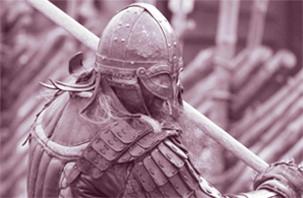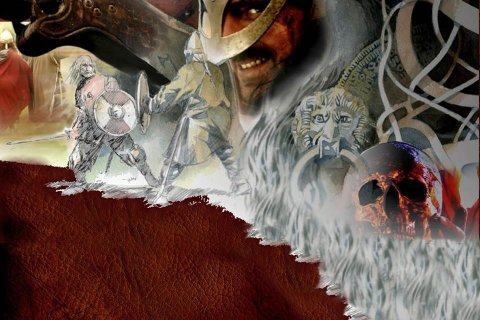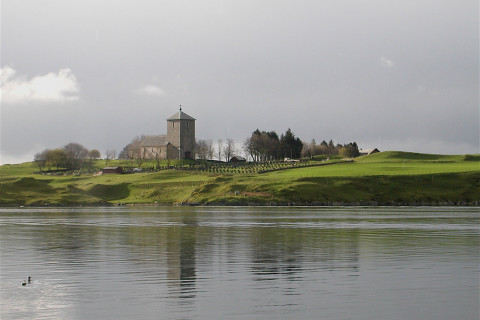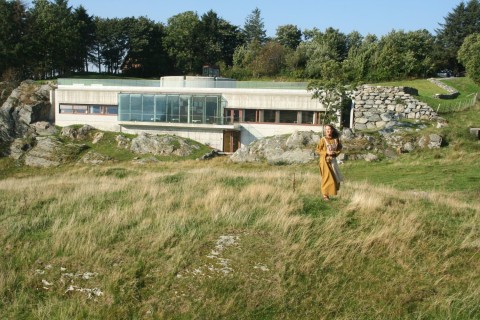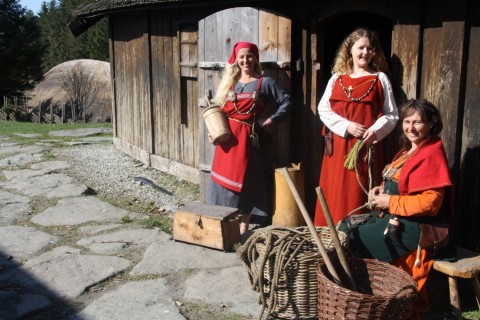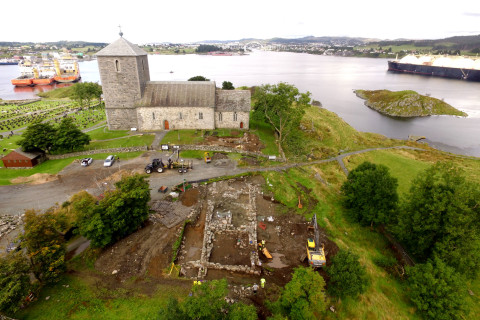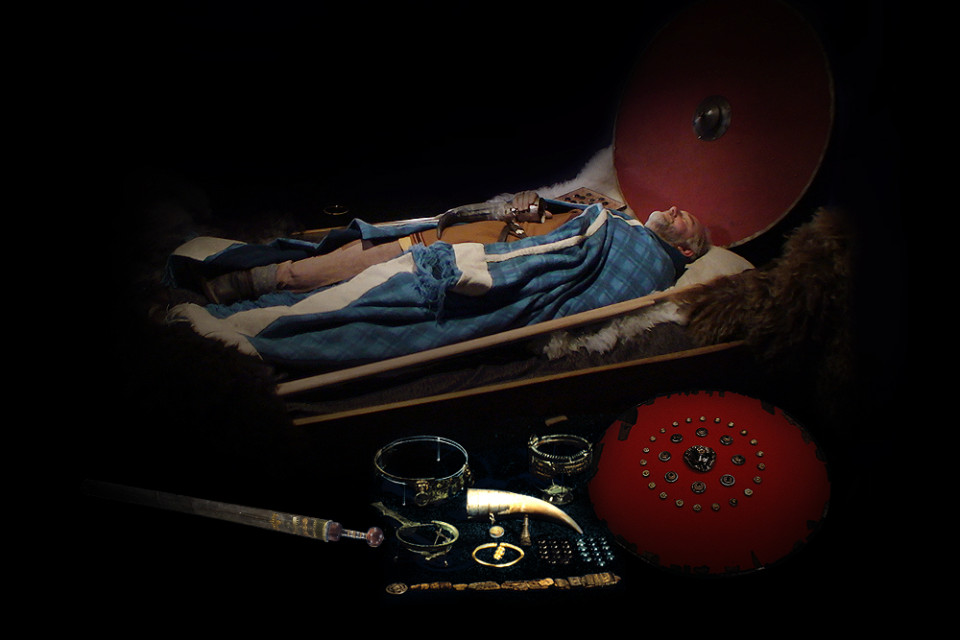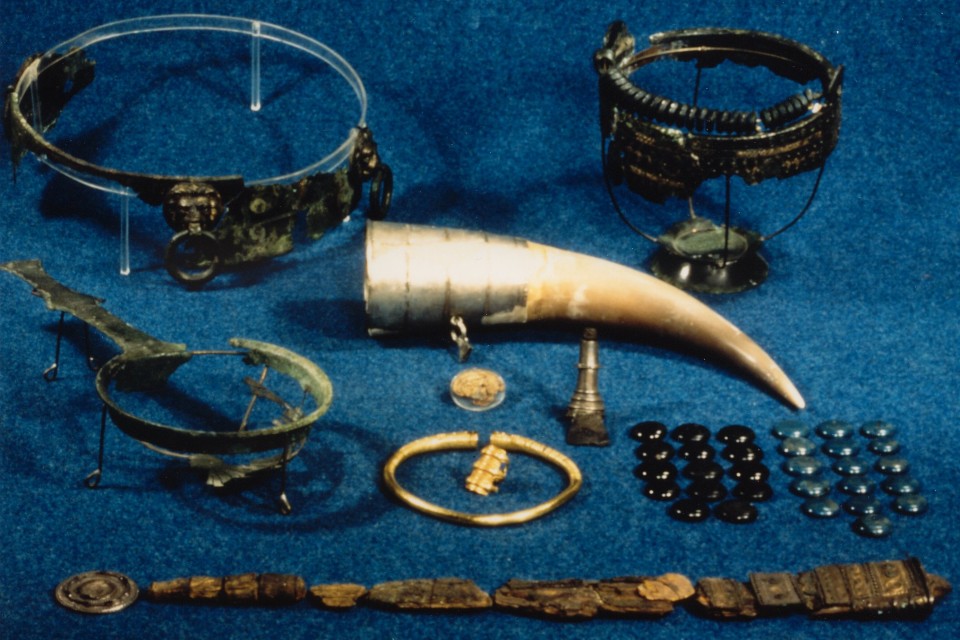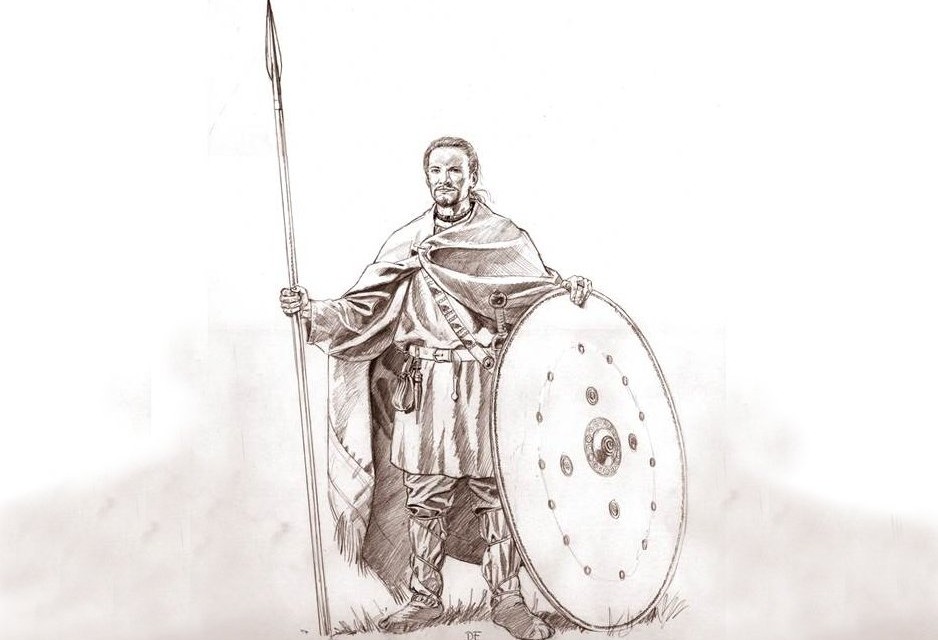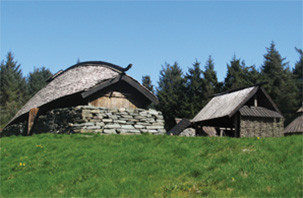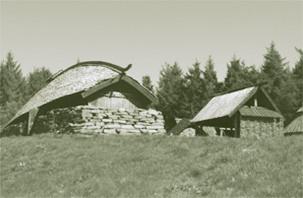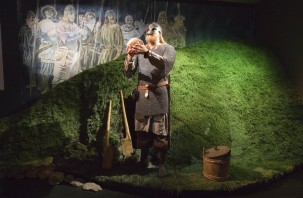Flag Mound Prince
Text: Marit Synnøve Vea
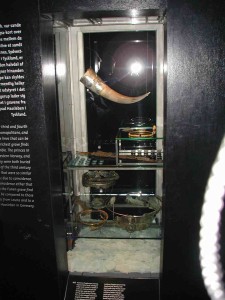
Some objects from the Flag Mound burial exhibited in the National Museum in Copenhagen. (Photo Marit Synnøve Vea)
The Prince of the Flag Mound lived during the 3rd century and may have been one of the first of the princes at Avaldsnes who was called “king” (Old Norse konungr). He was in any case wealthier and more powerful than many of the kings who reigned at Avaldsnes after him. We do not know the Prince of the Flag Mound’s real name, but he must have been famous in his own lifetime.
THE FLAG MOUND (FLAGGHAUGEN)
When the Prince – or King – of the Flag Mound died, he was buried in a large mound at Avaldsnes. The mound was 43 m in diameter and 5 m high, but it looked even larger than this because of its location on the edge of a ridge. The mound was opened in 1834/35. Inside, there was a chamber of slate slabs where the Prince lay in a coffin of oak planks surrounded by birch bark.
The pagan circle of five monumental stones to which the Virgin Mary’s Sewing Needle belonged, may have been erected in the time of the Prince of the Flag Mound. Perhaps the princes at Avaldsnes had already begun claiming in the 3rd century that they were descended from divine beings?
THE SCANDINAVIAN GRAVE FROM LATE ROMAN TIMES WITH THE MOST GOLD
The Prince of the Flag Mound was buried with more gold than any other prince in Scandinavia at this time. With him in the grave were also beautiful Roman imported goods and weapons.
“THE LORD OF THE RINGS”
The Prince of the Flag Mound was buried with a neck ring of gold. The neck ring weighs 590 grams and appears to have been opened many times in order to place it around his neck. The Prince of the Flag Mound is the only person we know of in Norway who was buried with a neck ring of gold. As such, this object represents an exceptional status symbol; on the Continent, gold neck rings are only found in graves containing the very wealthiest of objects, where even the points of arrows are made of silver. Lower down in the hierarchy, we find people with bracelets of gold, followed further down by those with finger rings.
In addition, three smaller finger rings of gold were found with the Prince. Three other finger rings were found in a secondary burial in the Flag Mound.

The Prince of the Flag Mound is the only person we know of in Norway who was buried with a neck ring of gold. (Foto Ole Jakob Vorraa)
A EUROPEAN WARRIOR PRINCE
In the 3rd century, Avaldsnes was a top-ranking political hub in Northern Europe. A few graves of similar status exist in parts of Germany and Eastern Europe. Close contact with the Romans must have been a key source of the wealth acquired by the Prince of the Flag Mound.
WAGNIJO, NITHIJO OG LAGUTHEWA
The Prince of the Flag Mound may have been a member of the elite who sent an army of 1000 men to Jutland, where they lost a battle. After the battle, their weapons were sacrificially laid in a marsh at Illerup in Jutland. Runic inscriptions reveal the names of three men belonging to the military elite of this army: Wagnijo, Nithijo and Laguthewa. Could one of these have been the Prince of the Flag Mound? Or was he a descendant of one of these three military commanders? Whatever the answer, the Prince of the Flag Mound was the most powerful prince on the Norwegian coast at this time.
THE NEW WARRIOR PRINCE
The riches and weapons in the Flag Mound point to important developments in Northern Europe. A small number of princes have become very powerful. During the Late Roman Period, there was war and turmoil in Europe. Germanic tribes were attacking the borders of the Roman Empire. The Prince of the Flag Mound may have been a northern chieftain who ttook part in these battles.
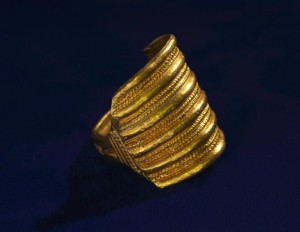
Finger ring from from the Flag Mound. (Photo Bergen Museum)
ENORMOUS WEAPON SACRIFICES IN DENMARK
At Illerup in Jutland, large amounts of war equipment were found that had been smashed to pieces and sacrificially laid in a marsh some time during the 3rd century. The destroyed objects are a silent witness to around 1000 warriors who sailed over the Skagerrak in 50 ships. They disembarked on Jutland, fought in a terrible battle and were slain. The army that was beaten at Illerup had 4-10 commanders, 30-40 officers and warriors in divisions of cavalry, archers and spear and lance-bearers.
Perhaps the Prince of the Flag Mound was one of the elite who sent this army down to Jutland. Or perhaps his army and its commanders were slain at Illerup on their way home from serving in the Roman army?
WAS THE PRINCE OF THE FLAG MOUND AN OFFICER IN THE ROMAN ARMY?
The reason for the power and wealth we find at Avaldsnes in the Late Roman Age is that the rulers here were in contact with influential and rich Romans. The costly Roman weapons and Roman imports found in the Prince of the Flag Mound’s grave bear witness to this. So how could a prince from Western Norway come into contact with the powerful Romans?
The sons of Germanic chieftains sometimes served for 10-20 years as high-ranking officers in the Roman army. They were trained in Roman warfare, administration and culture. Germanic officers of this kind could be sent to far-flung parts of the Roman Empire before they returned home with great riches and knowledge. The Prince of the Flag Mound may have been one of the officers who served in the Roman army some time during the 3rd century. His weapons show that he had been promoted to a very high military rank.

NORTHERN ROGALAND AND SUNNHORDLAND Distribution of gold rings and luxury goods from the Late Roman Period which can be connected with the Flag Mound. The localization of objects shows that the Prince was interested in having control over strategically important places along the communications routes. (After Endre Elvestad)
TRADE WITH THE ROMAN EMPIRE
There was certainly trade between the Roman Empire and Western Norway at this time. Some goods from Norway may have been in demand for equipping the Roman troops, which at their height comprised 650,000 men. It is likely that the Prince of the Flag Mound had the responsibility of administrating this trade.
THE RIGHT TO TRADE WITH THE ROMANS WAS A PRIVILEGE
The right to trade with the Romans was a great privilege bestowed on a few chosen rulers. To achieve this, the Prince of the Flag Mound must have had a network of alliances and contacts with other princes on the Continent.
THE WARRIOR PRINCE WHO BECAME A KING OF PEACE
The Prince of the Flag Mound may have won great power due to his prowess in war and his ability to build alliances with other warriors. Later on, it must have been important for him and his descendants to use this power to bring about peace and legal procedures to safeguard shipping and trade along the coast. The burial mounds and standing stones that stood along the strait of Karmsundet signalised this power to the people sailing through.
In order to safeguard coastal trade, the Prince of the Flag mound also needed a network of loyal chieftains and allies in his own region. We can see traces of a network of this kind in Northern Rogaland and in Sunnhordland. Here there are many graves containing gold rings, weapons and luxury goods. Perhaps these belonged to the Prince of the Flag Mound’s circle of chieftains and warriors?
BANQUETS AND GIFTS – IMPORTANT FOR THE ELITE
In the Prince of the Flag Mound’s grave there were beautiful Roman objects designed for the table. It is likely that the Prince used these when he invited guests to a banquet. Banquets and the offering of gifts were extremely important activities for the elite. They promoted alliances and bonds of loyalty between the Prince and other influential men to whom he was not related.
During the banquet, rich gifts would be given as a confirmation of these alliances. Costly objects from the Roman Empire were important symbols which made it possible to stay in power. If you had control of magnificent objects, you would also keep control over the bonds that held society together.
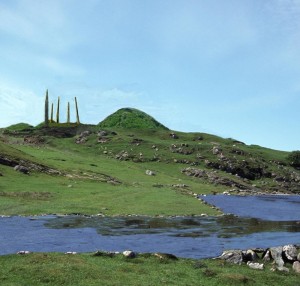
This is how the Flag Mound and the five monumental stones might have looked like in the landscape.
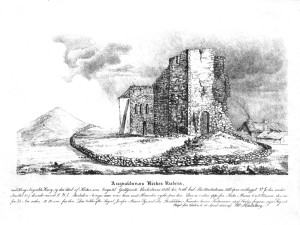
St. Olav’s Church before restoration. The Flag Mound to the left. (Sketch by Nils Hertzberg, 1828)
THE NAME FLAG MOUND
The burial mound was apparently given the name of Flag Mound because a flagpole stood there in recent times. (1) (2) Others believe the name comes from the Old Norse flagð, which means troll. (3)
The mound has also been called the Cow Mound (4) and King Augvald’s Mound. Tormod Torfæus is one of those who named the mound after King Augvald. Torfæus, who died long before the Flag Mound was opened, believed that Augvald lived in the 3rd century, even though the old genealogies dated his life to between 500 and 700 AD. But many generations can disappear from ancient family trees… (5) and maybe Augvald is actually a name associated with a number of rulers at Avaldsnes? (6)
LIST OF FINDINGS FROM THE FLAG MOUND
Notes:
1. Lars Skadberg, 1950 p. 16. «Olavskyrkja og Kongsgarden på Avaldsnes». (Nils Sund Forlag)
2. J. K. Christie: “Antikvarisk historisk tidsskrift, Urda” 1847: «Som man indseer, skriver dette Navn sig fra en paa Høien oppreist Flagstang»)
3. Håkon Reiersen, 2009: “The Central Place of the Avaldsnes Area, SW Norway. An Analysis of Elites and Central Functions along Karmsund 200 BC – AD 1000″
4. J. K. Christie: “Antikvarisk historisk tidsskrift, Urda” 1847. «For denne sidste Mening taler vel intet, uden en uhjemlet Beretning om, at høien ved Almuen skal være kaldt Kohaugen eller Kjyrehougen. (….) Kohøien maa nu blive at søge etandetsteds, men i Nærheden, og er maaske den – knappe tohundre Skridt sydenfor Augvaldshøien (Flagghaugen) beliggende overmaade store, nu saakaldte Kjelderhoug, hvori for en del år siden groves en Potetkjelder, ved hvilket Arbeide man paastaar en Bonde, der foretog Gravningen, skal være bliven rig; idetmindste var hans pludselige Overgang fra Armod til velstand etter Kjeldergravningen Folk paafaldende.»
5 .Tormod Torfæus, “Historia rerum Norwegicarum”, bind 1, (Eide Forlag 2008)
6. Marit Synnøve Vea. 1999. “Den fabelaktige Augvald og hans ætt, Et hus med mange rom. Vennebok til Bjørn Myhre på 60-årsdagen”. (AmS-Rapport, 11b , eds. T. Gansum & A. Opedal. Arkeologisk Museum, UiS)
Main photoes/illustrations:
KIB media, Gunnar Strøm, Bergen Museum, Dag Frognes, Archaeological Museum, UiS
Back

